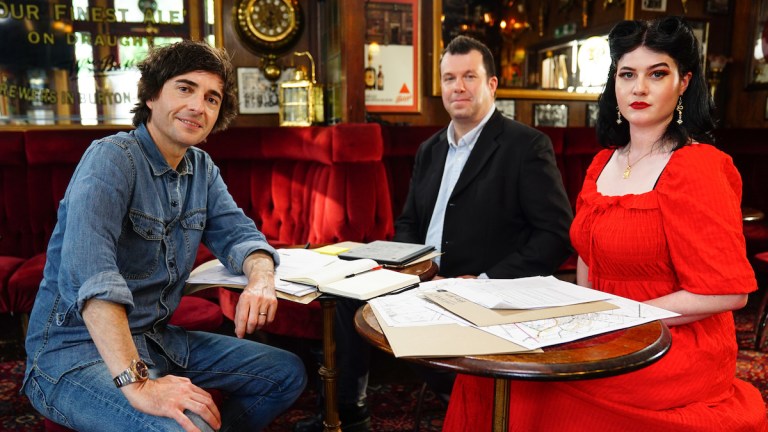Uncanny Episode 2: Poltergeist or Hypnogogia? Two Things Can Be True at the Same Time.
Sleep paralysis and hallucinations or the ghost of a boy? Or could it be both?

Episode two of Danny Robins’ Uncanny, the TV version of his well loved podcast of the same name, presents us with an interesting thought experiment. Somewhere in between the hardcore skeptics and credulous paranormal believers, there is a third sector – the “I dunno, maybe? A bit?” camp. And for those of us who fall into that sector this one is a particularly fun episode to navigate, presenting us with a man who definitely did think he saw something at 16 (no fibbing here), three generations who reported witnessing a similar apparition and some hard to explain phenomena (the toilet!) but also offering compelling explanations for some of it. Sleep paralysis is a very reasonable explanation for what Ian experienced as levitation, his nephew Alex even says he thought he had an imaginary friend rather than a ghost (he probably did). And hypnogogia (more on this in a bit) is certainly a possible option to explain the sightings.
Could both these things be true at the same time?
Ian is a bloke in his 50s, a deputy head teacher who grew up in County Durham in the ’80s. There, he lived with his family in a house called The Garth. Co. Durham had been a mining town, and The Garth was owned by a collier. When he was around age 16 Ian started experiencing phenomena – phantom footsteps on the stairs, crashes and bangs from downstairs when he was alone in the house, sounds of the toilet flushing by itself and eventually visions of a little boy in Victorian clothing. Ian was so scared that he wrote a letter to the Society for Psychical Research (SPR) asking for help. The SPR actually called Ian but at the time his dad was so cross that Ian had to end the contact (Robins is able to verify both the letter, the call and the crossness of Ian’s dad, through SPR records).
In the present day Robins and Ian visit The Garth – the man who lives there now seems like a very nice chap – and attempt to recreate the noises from the kitchen Ian heard. Ian is convinced he knows what he heard. Robins is generous and empathetic. In his own house Robins tries to make his toilet flush by itself and is unable. He calls out a plumber who confirms it wouldn’t be possible to create a full flush without some mechanical movement.
Ian reveals when he was a teenager his mother also said she saw the ghost of a young boy in the house, describing the boy in the same way as Ian. Later Ian’s sister and nephew move into The Garth and his nephew describes what he had thought was an “imaginary friend” who he played with and who he describes in similar terms to Ian and his mother. Could this be the ghost of a deceased child miner? Robins discovers that boys as young as 14 were sent down the mines and frequently died (records support this), and even though the house was built in the 1930s (ie. well after the Victorian era), it was built right on top of a former mine.
If you want to believe in ghosts there’s a great story here. But as ever, explanations are possible.
Robins’ experts Ciaran O’Keeffe (psychologist and skeptic) and Evelyn Hollow (paranormal psychologist and believer) duke it out, with O’Keefe suggesting hypnogogia – the state between sleep and wakefulness where people often experience hallucinations – as a possible explanation for some of the phenomena. Sleep paralysis (whereby your brain is awake but your body is paralysed) could also easily explain some of Ian’s nocturnal experiences. A bit of a coincidence that all these things should happen at the same time, to the same family, says Evelyn. But on the other hand, no, it’s really not. If Ian grew up in a mining village, during the time when the mines were in turmoil and many local people were losing their livelihoods, it’s not improbable that he’d have heard tales about the Victorian era of mining where young kids were sent down the mines. If he was experiencing weird noises when on his own in the house overnight aged 16 (and though he might not wish to admit it, it can be a bit scary being left alone overnight when you’re a youngster), it might have upset him. If he’s experiencing unsettled sleep and the dream states which come with them, why wouldn’t his mind project the same image of the little boy into those dreams?
What about the fact that three generations of the family all reported similar spooky sightings? Well, yeah, but what about the fact that they don’t all agree on whether it’s a playful pal or a scary poltergeist, only Ian talks about levitation and toilet flushes and the family who currently live in the house haven’t experienced anything of the sort?
And this is the joy of Uncanny, rather that bullishly insisting the case must be supernatural, the show allows us to enjoy the story, be taken along for the ride with the possible history of the “ghosts” unfolding, and treats its subject with the utmost respect, while gently offering explanations for what might really have happened. And if you’re an inbetweener, you can believe that there was a bit of a ghost, and also a bit of sleep paralysis and bad dreams too.
Not the toilet though. No one could explain that.
Uncanny is a three part series which airs on BBC Two on Fridays at 9pm.
